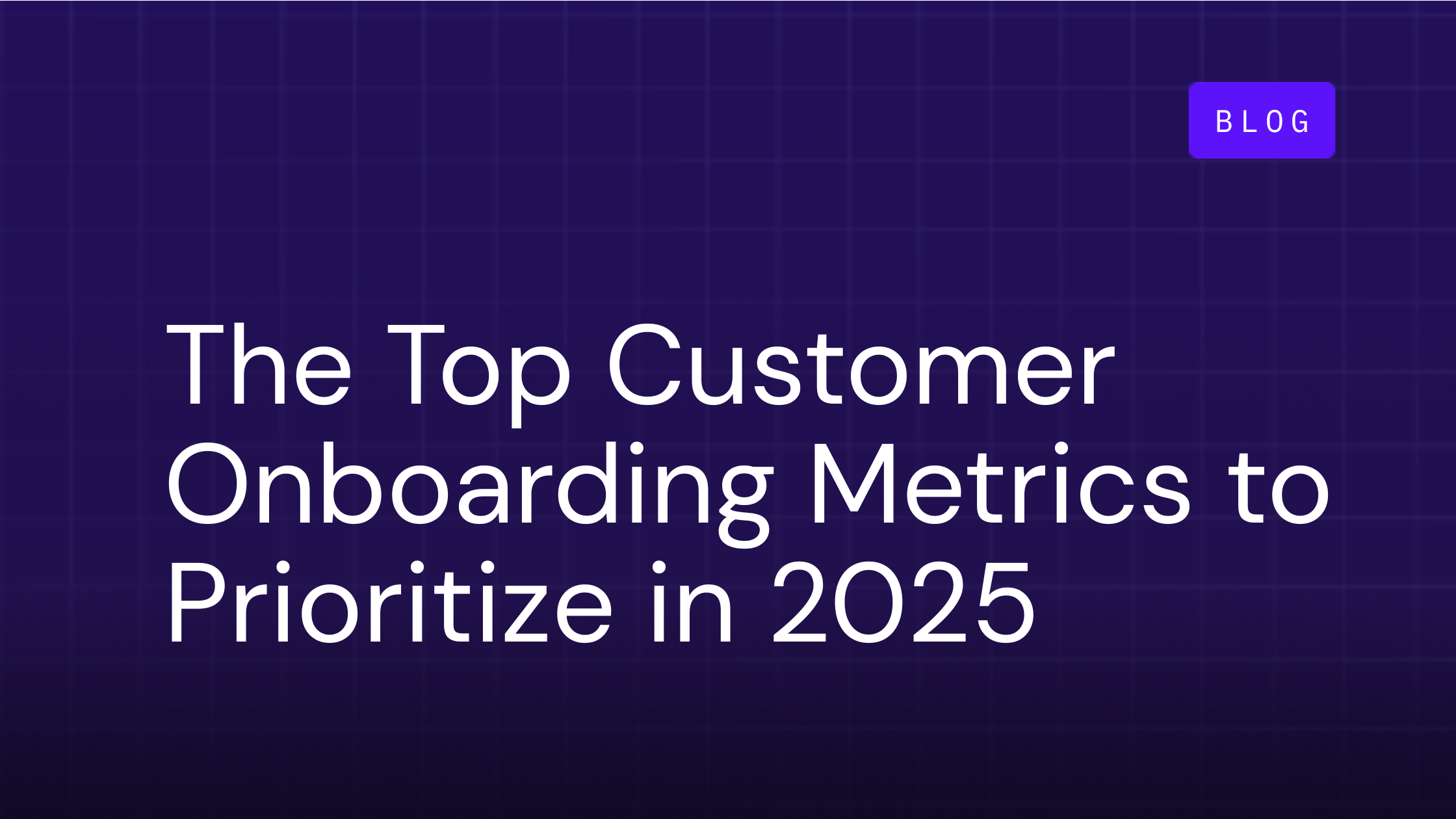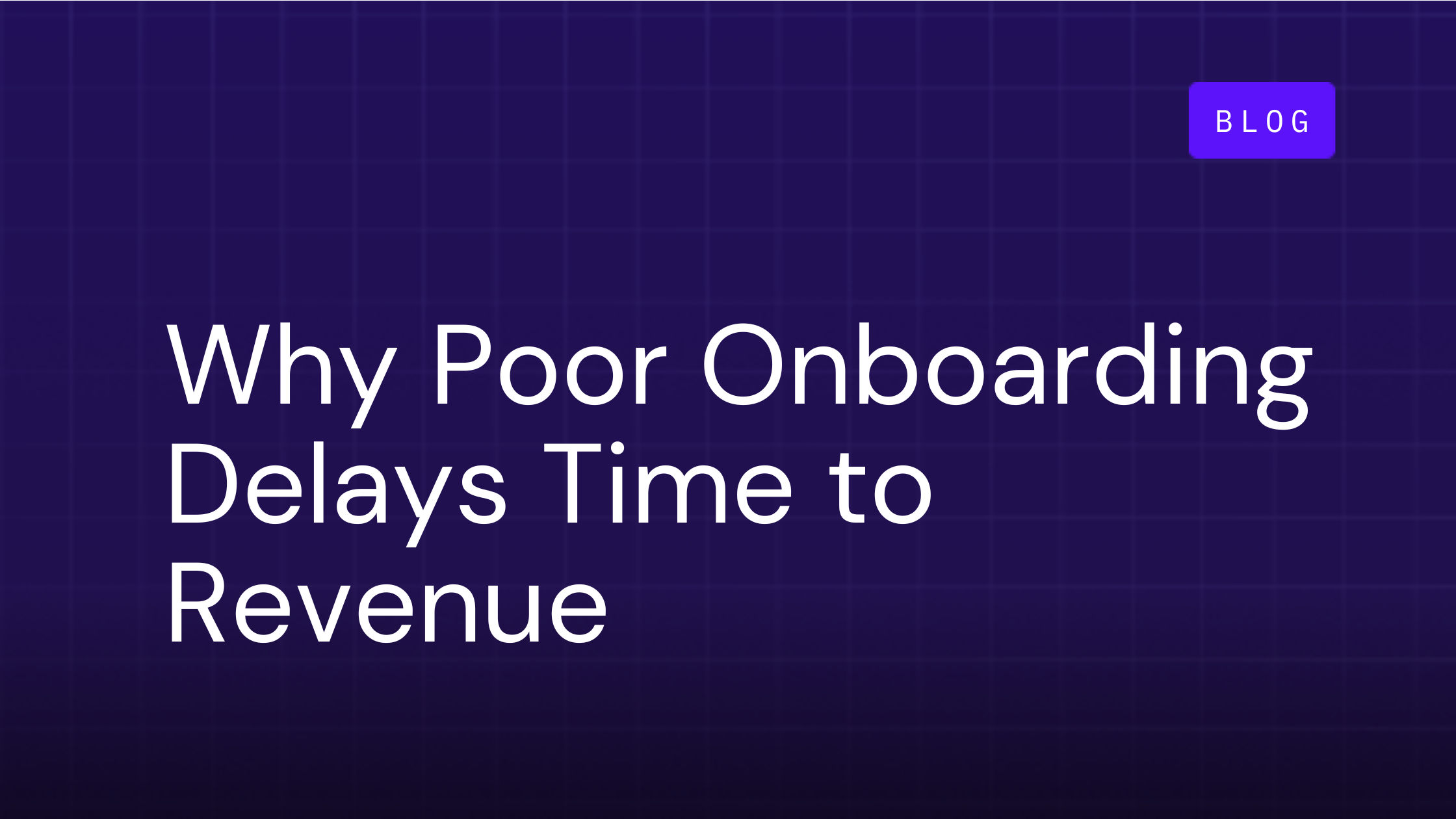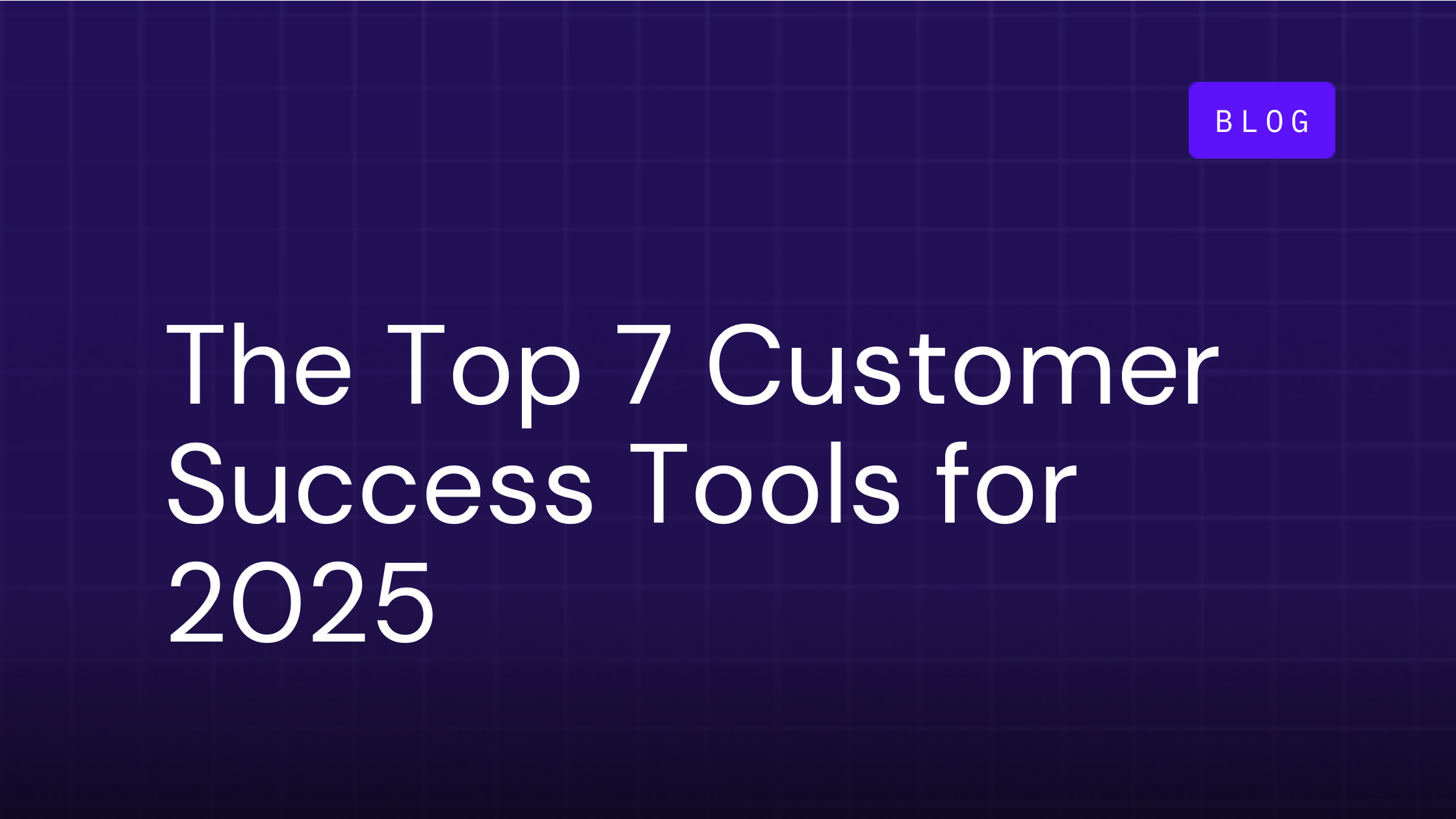The 8 Hidden Revenue Killers in Your Onboarding Process
Published: October 31, 2025

Table of Contents
Revenue loss doesn’t just happen when a customer churns. Revenue is at risk the moment a customer signs a contract and onboarding begins.
When a deal is signed, customer expectations are at their highest – and the clock starts ticking on your product delivering on the promises made during the sales cycle. It’s also the crucial point in a customer relationship when trust is forming. You’ve got one chance to deliver a great first impression – and if friction sets in early and onboarding momentum is lost, regaining it is a challenge.
Onboarding is inherently complex – involving multiple stakeholders, varying levels of engagement, and a host of technical requirements. Despite best intentions, most onboarding processes are still pieced together with manual handoffs, scattered updates, and disconnected tools, creating friction that frustrates both teams and customers. Frustration often leads to customers losing clarity, confidence, and urgency. And just like that, your hard-won customer (and revenue) are at risk.
In our 2025 State of Onboarding: The First 90 Days, over half of Customer Success leaders said friction in onboarding directly impacts revenue realization.
Customer onboarding is upstream of every potential customer outcome. It impacts long-term revenue from day one. But it’s not just about churn. It’s about delayed revenue recognition for consumption-based businesses, missed expansion opportunities, and slowed adoption forcing costly fixes and unsustainable team heroics.
This guide breaks down the 8 most common onboarding mistakes that silently kill revenue opportunity and gives clear steps on how to fix them.
1. No Visibility = Delayed Time-to-Revenue
When customers can’t see what’s next, don’t have clear expectations and accountability, and can’t see progress, they often become disengaged. Confidence plummets, deadlines get discarded, and they’re left second-guessing their investment.
Instead of feeling guided along the path to success, your customer feels lost, in the dark, and left to figure things on their own.
Lack of visibility isn’t just an inconvenience. It creates a ripple effect: slowed onboarding, delayed product adoption, and prolonged time-to-value. Worse, the loss of momentum can lead to your champion losing credibility with their internal stakeholders, now doubting their decision making and lessening their buy-in.
And when outcomes take too long to materialize, expansion conversations become awkward, and renewal decisions are pushed back (or lost entirely).
What is the revenue impact of no visibility for customers?
Longer time-to-value means slower ARR recognition, delayed renewals, missed expansion opportunities, and lower customer confidence early on. It weakens your chance to prove ROI fast, which is critical in today’s retention-focused economy.
How to fix delayed time-to-value in the customer journey?
Give customers a one-stop portal that, like TurboTax, welcomes them, shows them what’s coming next, gives real-time progress updates, uncovers what’s missing, and breaks down who’s responsible for each task. This anytime visibility builds confidence, sets clear expectations, and fosters accountability – keeping everyone moving forward. When customers feel led and can see progress, they feel validated in their decision. Empowered customers move faster toward value, adoption, and growth, directly accelerating your revenue and expanding customer lifetime value.
2. Manual Tasks = Cost Inefficiency
When your team is stuck in their inbox, endlessly chasing updates, sending reminders, and reformatting spreadsheets, onboarding becomes an inefficient grind for everyone. This isn't just low-impact work; it prevents CSMs from engaging in high-value strategy and relationship-building. These manual processes will not scale as customer volume grows.
Tasks slip through the cracks, timelines get missed, and customers can feel the disorganization – and they wonder if you were truly ready for their business. This inefficiency drags down your entire onboarding operation, delaying activation and revenue recognition. Worse, it leads directly to team burnout and high turnover. Each departure means lost customer knowledge, a relationship reset, and the costly, time-consuming cycle of rehiring and retraining which is a significant deterrent to your growth.
What is the revenue impact of manual onboarding work?
Manual onboarding work creates a cascading revenue drag. It slows velocity, deferring ARR recognition and puts pressure on team bandwidth. It limits your capacity for customer acquisition and puts constraints on the volume of customers you can support, raising the risk of churn and reducing opportunities for expansion.
Over time, this compounded pressure forces burnout and employee turnover which leads to the costly recruiting and training cycles, further risking customer relationships.
How to fix onboarding bottlenecks and CS team burnout?
Provide dynamic automation for non-human touch tasks, to deliver personalized, right-time reminders, approvals, task assignments, data entry, file uploads, and status updates. This strategic shift equips your team to prioritize what truly matters: engaging in strategic conversations, providing impactful customer coaching, and driving timely adoption.
An optimized, efficient process accelerates customer value realization and fosters a more robust and scalable business for sustained growth.
3. Inconsistent Experiences = Diminishing CLV
Naturally, every CSM is going to run onboarding a bit differently. They each have different personalities, strengths and weaknesses. Some overcommunicate, others underdeliver. Some are organized and do better with the administrative details, while others are more relationship-builders and are better at talking to customers.
What is the revenue impact of inconsistency?
These nuances add variance to how you may want your brand and product perceived. After winning a customer through a complicated deal cycle, the last thing you want is a dicey first experience outside your control, instantly eroding confidence in your ability to deliver value.
If the relationship got off to an awkward start, you can kiss expansion conversations goodbye. Risking revenue due to inconsistent delivery is a game of Russian roulette you don’t want to play.
How to fix inconsistent delivery?
Standardize your onboarding workflow by creating repeatable playbooks. This approach removes guesswork, helping ensure a consistent experience for every customer. A structured process still allows for the necessary human element while maintaining the predictable, high-quality experience a brand aims for. The outcome is a more unified and positive first impression, which generally supports trust and the customer's journey toward realizing value, contributing to their overall lifetime value (CLV).
4. Clunky Project Management Tools = Revenue Leakage
You just won a customer, congrats! Now it’s time to get them onboarded. Sounds simple, but instead of a straightforward process on the rapid path to success, they’re unknowingly entering what feels like a back-office corporate experience. Otherwise known as a project board launched from Jira, Asana, Trello, shared Notion board or spreadsheet. These tools, which are great for internal tasks and processes, are messy and overwhelming when used for the customer experience.
Asking your customers to clunk through your internal systems creates unnecessary friction and clutter right when clarity and confidence are so important.
What is the revenue impact of using the wrong tool for the job at hand?
Forcing customers into your internal projects and tools creates a lousy first impression, instantly diminishing trust and perception of your brand as forward-thinking. They just purchased your product or service to help them, not create more work. And trust, as we know, is the foundation for effective collaboration, deeper adoption, and future expansion opportunities.
When customers are left to decipher your internal workflows, it makes it hard to be confident that they’re on an intentional path to value. This early friction can derail recognition of potential upsells and renewals before they even become a conversation.
How to fix a poor experience?
The solution is simple yet powerful: separate internal tooling from the customer experience.
Invest in a purpose-built customer onboarding platform that provides a clean, intuitive, and dedicated space for your customers. This removes unnecessary friction by presenting only what’s relevant to each customer, in a format they understand.
Making communication really easy, offering clear progress visibility, and providing a delightful user experience reinforces trust. And a positive, professional first impression can help speed up time-to-value and lays a strong foundation for long-term customer relationships and revenue growth.
5. Spreadsheet Overload = Capacity Constraints
Spreadsheets are universally familiar, but using them to track customer onboarding is a recipe for disaster and capacity constraints. In a dynamic environment where there’s a lot of back and forth between teams, departments, partners, and customers, these docs quickly become outdated – leading to disparate versions and confusion around what’s what.
Even cloud-based docs and spreadsheets, designed for general collaboration, lack the structured end-to-end workflows, task management capabilities, and dedicated customer-facing features essential for a robust onboarding journey. Information can be scattered, changes can be hard to track systematically, and context often lives outside the document itself, requiring constant human intervention to keep everyone aligned.
Stakeholders miss deadlines because they’re working off old information or non-linear tasks, and progress updates become a manual, time-consuming effort of chasing down data. This fragmented approach means you’re always reacting, never truly proactive, and your team is heroically struggling to keep up with the real-time demands of customer activation.
What is the revenue impact of using the wrong tool for the job at hand?
Despite their “real-time” nature, these generic collaborative documents create subtle but significant revenue leakage. Their illusion of progress without providing concrete task management or clear accountability leads to missed steps and stalled momentum.
Unmanaged expectations creep in when customers see a living document but lack clear understanding of priorities, ownership, or deadlines. This ambiguity delays time-to-value, pushing back activation, usage, and subsequent revenue recognition. Ultimately, the lack of a structured, guided experience shreds customer confidence, and makes expansion conversations awkward if not impossible.
How to fix tooling?
Just like marketing automation or CRM, your onboarding deserves a purpose-built solution. Transition from generic docs to a customer onboarding platform designed for this mission-critical function. For the first experience your buyers now have as a paying customer, they need and deserve a structured, visual workflow with clear ownership and progress tracking. No guesswork – just consistent, personalized experiences in a way you can scale. Now you have clear, guided, transparent experiences for every customer, accelerating value realization and securing predictable long-term revenue.
6. Bloated Headcount = High Fixed Personnel Costs
Don’t just hire more CSMs to solve bottlenecks; first, ask if it’s a process problem. Bringing new people into an inefficient process is expensive (hiring, training, time) and only exacerbates existing issues. If CSMs are bogged down by tasks that can be automated or custom journeys, new hires won’t fix the underlying inefficiency.
What is the revenue impact of throwing more headcount at the problem?
This approach leads to inflated fixed personnel costs and continued delays in activation and revenue. It limits true scale, fuels expensive team burnout and turnover (lost knowledge, constant rehiring), and directly hinders sustainable growth.
How to fix inefficiency?
Transform your onboarding with strategic automation and a centralized platform before expanding headcount. Automate non-human tasks and implement playbooks. This unlocks significantly more scale from your existing team who can focus on value-added work, driving outcomes faster and ensuring efficient and more profitable growth.
7. Approval Chaos = Pipeline Backlog & Revenue Blockage
When every single step in onboarding requires an internal approval or data validation (aka manual touch points often managed over multiple email or calls), chaos ensues. Onboarding momentum grinds to a halt as different teams become bottlenecks and operate with no clear visibility into dependent tasks that are stuck.
This unstructured, reactive approach means progress is constantly blocked by a lack of clarity and accountability, creating a frustrating experience for both your internal teams and your eager customers who are excited to get going.
What is the revenue impact of approval chaos?
This internal approval chaos directly translates into a pipeline backlog and revenue blockage. Delays pile up as tasks sit unapproved or data remains unvalidated, leading to slower implementation cycles. This prolongs the time required to recognize ARR, especially for consumption-based models.
Beyond direct revenue delays, this friction creates a poor first impression for customers, undermining confidence and trust. It also wastes valuable team time in chasing approvals, diverting resources from proactive engagement and hindering your ability to scale customer activation.
How to fix approval chaos?
The solution is to automate approval processes and data validation with dynamic workflows within a centralized platform. Establish clear rules for who signs off and when, and build these directly into your onboarding process. Implement a system that provides clear, real-time visibility into all dependent tasks, allowing your team to instantly see where things are stuck, proactively nudge stakeholders, and unblock progress.
This strategic shift cuts out manual bottlenecks, speeds up task completion, and ensures a smooth, predictable path to activation that directly unlocks your pipeline, expedites revenue recognition, and creates a differentiated customer experience.
8. No Feedback Loop = Unforeseen Revenue Attrition
Many onboarding teams operate under the assumption that “no news must mean good news.” Once a customer begins onboarding and the active interaction stops, without formal check-ins or feedback requests, it’s wrongly assumed they’re all set.
The absence of service tickets or complaints is mistakenly equated with customer satisfaction, leading teams to miss early warning signs of disengagement. This “set it and forget it” mentality means you're flying blind, unaware of subtle frustrations or unmet expectations – or worse, silent abandonment, until it's far too late at renewal time.
What is the revenue impact of no feedback loop?
Operating without an onboarding feedback loop leads to unforeseen revenue attrition. By missing early warning signs of disengagement, you lose the opportunity to intervene proactively and course-correct.
This results in silent customer retreats, increased churn rates before renewal, and a reduced CLV. Without understanding friction points early, you also miss opportunities for timely support, deeper feature adoption, and identifying expansion potential. Essentially, you're allowing revenue to quietly slip away, unaware until the impact is fully realized on your bottom line.
How to fix unforeseen revenue attrition?
The solution is to build continuous feedback loops and satisfaction checkpoints directly into your onboarding journey. Treat onboarding as an active revenue lever – not a simple checkbox – by proactively soliciting customer sentiment. But you can’t sustain it if done manually.
Rather, implement automated pulse checks, in-app surveys, and strategic check-ins at key milestones to gather real-time insights. Use an onboarding platform to collect and analyze these signals, allowing your team to identify and address disengagement early. This proactive approach ensures you can rapidly respond to potential issues, reinforce value, solidify the customer relationship, and ultimately prevent unforeseen revenue attrition, leading to higher retention and greater lifetime value.
What is a customer onboarding process?
Customer onboarding is the structured process of guiding new customers from the moment they sign a contract through setup, training, and initial product use. The goal is to help them quickly realize value from your product or service while building confidence and trust in your company. A strong onboarding experience sets the tone for the entire customer relationship and directly impacts retention, adoption, and long-term revenue.
Why is customer onboarding important?
Customer onboarding is critical because it’s the first real test of your company’s ability to deliver on the promises made during the sales cycle. It influences time-to-value, customer satisfaction, and expansion potential. When onboarding is disorganized or slow, trust erodes and momentum stalls — delaying revenue and increasing the risk of churn. Onboarding isn’t just a tactical phase; it’s a strategic revenue moment.
How do you improve your customer onboarding process?
Improving onboarding starts with identifying the biggest friction points for both your team and your customers. Automate manual tasks, replace internal project tools with a purpose-built customer-facing experience, and standardize your process with playbooks. Give customers clear visibility into what’s next, who’s responsible, and how they’re progressing. And most importantly, build feedback loops to uncover and address issues early. These changes accelerate time-to-value, reduce inefficiencies, and drive long-term growth.
How do you create a customer onboarding process?
To create an effective customer onboarding process, map out each stage of the journey from handoff to full adoption. Define key milestones, assign internal and customer-facing responsibilities, and build workflows around what success looks like for different customer segments. Incorporate automated touchpoints to keep things moving and standardize your process with templates and playbooks. The result should be a repeatable, scalable framework that delivers consistent, high-impact onboarding experiences.
How do you measure customer onboarding success?
The most effective onboarding teams track metrics tied to both customer progress and business outcomes. Core metrics include time-to-value, task and milestone completion rates, product usage in the first 30/60/90 days, and customer sentiment gathered through feedback loops or surveys. You can also track internal metrics like CSM workload, onboarding cycle time, and delayed activations. These insights help you continuously improve the process and demonstrate the revenue impact of onboarding.
Related Posts:

The Top Customer Onboarding Metrics to Prioritize in 2025
Offering exceptional customer onboarding gives your company a competitive advantage that yields results in the long-term. It's...

Why Poor Onboarding Delays Time to Revenue in Consumption-Based SaaS
In consumption-based SaaS models, onboarding isn’t just a box to check. It’s the fuse that ignites the revenue engine. Until your...

The Top 7 Customer Success Tools for 2025
Customer success tools help companies manage the customer experience — from pre-sales to renewals. Admins or CS leaders typically...